There are two approaches in modern rhinoplasty. Open structure and closed structure rhinoplasty. Until 1970, all rhinoplasty procedures were performed with incisions inside the nose. This was the so-called closed rhinoplasty approach.
Open Structure Rhinoplasty
|
|
Open rhinoplasty became popular during the recent years. It involves an inverted V-shaped incision on the nasal columella.
The skin of the nose is elevated, and the bones and cartilage of the nose are exposed. This allows the surgeon to have best visualisation of the anatomy and pathology of the nose. |
|
Open rhinoplasty is the approach preferred for difficult rhinoplasty cases. Its advantages are
|
|
Closed rhinoplasty
The closed rhinoplasty approach involves incisions inside the nostrils.
Surgeons usually opt for this approach in simple rhinoplasty cases, particularly when they need to remove the nasal hump or achieve a slight lifting of the nasal tip.
The greatest disadvantage of closed rhinoplasty is that the surgeon does not have immediate visualization of the nose anatomy.
To counter this disadvantage, we often use the Delivery approach.
Delivery approach
This approach involves two incisions made inside the nose. It enables us to expose the lower section of the nose but not the upper section.
It is usually selected for nose tip procedures
Nose tip correction
Tip Rhinoplasty refers to the correction of problems of the nose tip, i.e.:
- Bulbous tip
- Boxy tip
- Droopy tip
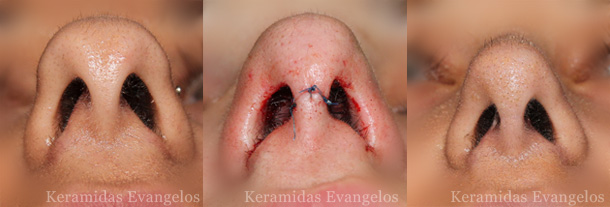 Bulbous tip - Boxy tip
Bulbous tip - Boxy tip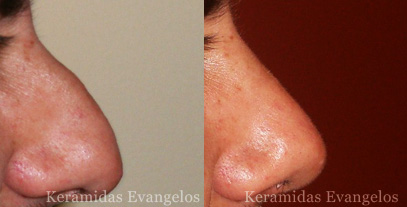 Droopy tip
Droopy tipThe nose tip is the lower third of the nose and is the most complex anatomical formation.
The slightest change on this area may cause a dramatic change on the face. This is why tip rhinoplasty is one of the most popular procedures.
Nose tip surgery may be performed through the closed, open or delivery approach.
However, because the nose tip is one of the hardest areas of the nose, surgeons opt for the delivery or the open approach.
In tip rhinoplasty we are able to change the volume, projection as well as the angles of the nose tip.
Nose tip surgery may range from very simple to very difficult.
Augmented rhinoplasty
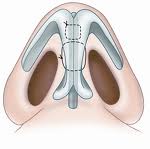
When we need to use extra material (graft) to support the nose, either for cosmetic purposes or for functioning reasons, the procedure performed on the nose is called augmented rhinoplasty.
We usually correct the projection of the nose tip by placing grafts. We may also correct the back of the nose or improve breathing.
The materials (grafts) used for nose augmentation are distinguished into artificial grafts and autografts. Most rhinoplasty surgeons, like us, opt for autologous tissues, since artificial grafts develop problems. The most popular grafts are:
- cartilage from the septum or ear
- rib graft
- fascia from the temporal fascia
In some cases, we may use a combination of these grafts.
These are the most difficult rhinoplasty procedures which are usually performed through the open approach.
Along with the grafts, we may use sutures inside the nose to change its anatomy.
Nasal septum deviation
Nasal septum deviation means that the septum of the nose has been displaced.
What is the septum?
The septum is a bone and cartilage structure dividing the two nostrils. It should generally be placed straight along the midline; nevertheless, in cases of nasal septum deviation it isn’t. 80 % of the people with deviated septum have the condition since birth or, most commonly, due to an injury.
So, is it necessary for 80% of the population who have developed septum deviation to undergo surgery? If septum is deviated but no functional problems have been developed (e.g. difficulty in breathing, sinus disorders, headaches etc.) then fixing the septum is not necessary.
It is advisable to correct the nasal septum when:
- The deviation is too big, i.e. the septum has been significantly displaced and may be responsible for various conditions such as chronic nasal congestion, headaches, breathing difficulty, snoring, paranasal sinuses disorders, face pain, frequent nose bleeding, noisy breathing (stridor) and sleep apnoea.
- When the nose is crooked on the outside and the patient wants to correct it.
- When we perform a plain rhinoplasty procedure on a big nose. If we reduce the size of the nose then the displaced septum may cause breathing problems. It is advisable to correct the septum at the same time.
Along with the septum, it is sometimes necessary to correct the conchae which are small bones on the sides of the nose.
Septum and nasal conchae correction last 45-60 min and are usually performed under general anaesthesia.
Rhinoplasty videos
Recovery after rhinoplasty
Rhinoplasty is pain-free procedure. Although it may sound strange, rhinoplasty is one of the less painful procedures.
However, there are certain things you must expect after surgery.
The nose will be covered with a small splint. A small tampon will be placed inside the nose. A small gauze will be put in front of the nose like a moustache to protect clothing from any secretion or minor bleeding. The splint will be removed in five days. In case of an open rhinoplasty, sutures will be removed in five days too. The tampon will be taken out of the nose in 16-24 hours.
You will experience some swelling and your eyes will be bruised. Swelling and bruising will last 5-14 days.
The patient is usually able to return to work in 8-14 days.
The result of the operation is visible in 2-4 weeks, but the nose will get its final shape in 6 months to 1 year.
At first, the nose will also feel blocked. However, it will slowly go back to normal. Warning: avoid blowing your nose or putting your finger inside it.
You shall take antibiotics for 5 days. You will also need to flush your nose with saline. You may take a bath on the same day. You just need to avoid bending over.
Standard rhinoplasty
A standard rhinoplasty is a surgical procedure during which we correct the nose hump and slightly enhance the projection of the nose tip. It is performed under General Anaesthesia through the closed approach and lasts about 20- 30 min.
Candidates for Rhinoplasty/Septum correction
- Nose hump
- Crooked nose
- Big nose
- Nose tip problems
- bulbous tip
- boxy tip
- droopy tip
- Difficulty in breathing
- Revision rhinoplasty
- Injury
- Cleft lip and palate
Chin surgery
Chin surgery aims at correcting the chin. This is performed either with chin augmentation or reduction.
A common aesthetic problem is the combination of small chin and big nose. In such cases, the patient is advised to undergo chin correction during rhinoplasty.
There are two methods of chin augmentation:
- If the patient has a good teeth alignment, we propose implant placement.
The operation may be combined with rhinoplasty. It lasts 30 min and consists of a small incision inside the mouth, where the gum and lower lip meet.
- If the patient has bad teeth alignment, the approach is absolutely different (cephalometric analysis and orthognathic treatment).
Revision Rhinoplasty
Secondary
Secondary rhinoplasty is performed to correct previous nose surgery.
Secondary rhinoplasty is the most complicated procedure. This is why, in such cases, most plastic surgeons use the open approach. It is advisable for secondary rhinoplasty to be performed one year after the first procedure because the cicatricial tissue will have softened and access to the nose will be easier.
Rhinoplasty complications
Complications are extremely rare
- Haemorrhage
- Inflammation
- Airway obstruction
- Septal perforation
- Saddle nose
- V deformity
- Tip deformities
- Cribriform plate fracture
Modern Rhinoplasty – Millimetre surgery
Long ago, Rhinoplasty on a person’s face was easily distinguishable. The outcome was similar since there was no variety in the nose shaping techniques.
However, this is not the case during recent years thanks to the development of open structure rhinoplasty, during which the surgeon has full visualization of the nasal anatomy and may therefore modify the nose with great accuracy and with the deployment of many different techniques (sutures, grafts etc).
Modern rhinoplasty aims at giving the patient the nose that best fits his/her face shape. Not all faces are the same. The same should apply for noses. The goal of modern rhinoplasty is to give the nose the most natural shape possible so that no one will be able to tell that the patient has undergone a surgical procedure.
This is why modern surgeons opt for the open structure rhinoplasty and use very advanced techniques such as suturing or grafting to achieve the desired result.
The Motto of modern rhinoplasty, particularly for difficult cases, is:
- Open structure reveals everything
- Grafts fix everything and
- Inside stitches change everything.
It is not by chance that open rhinoplasty is preferred by most plastic surgeons.




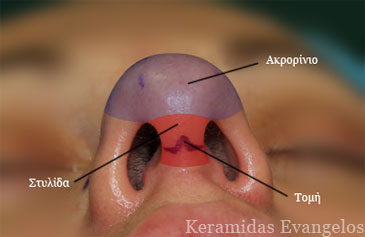
 Ρινοπλαστική βλεφαροπλαστική αυξητική στήθους
Ρινοπλαστική βλεφαροπλαστική αυξητική στήθους Ρινοπλαστική
Ρινοπλαστική Send us your questions
Send us your questions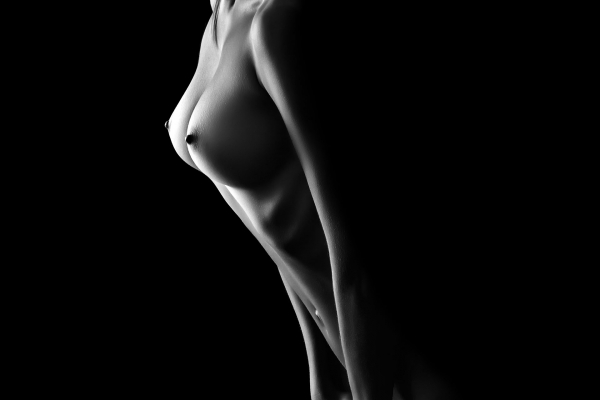

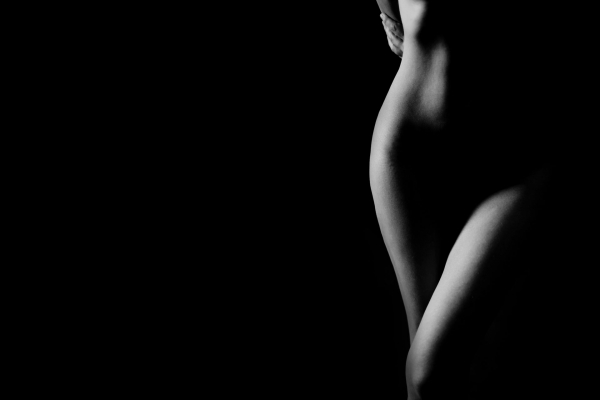

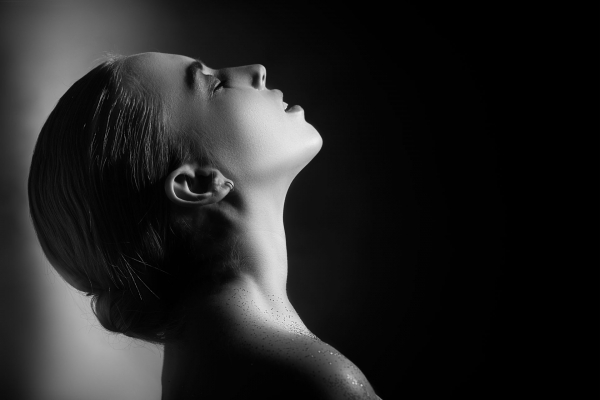




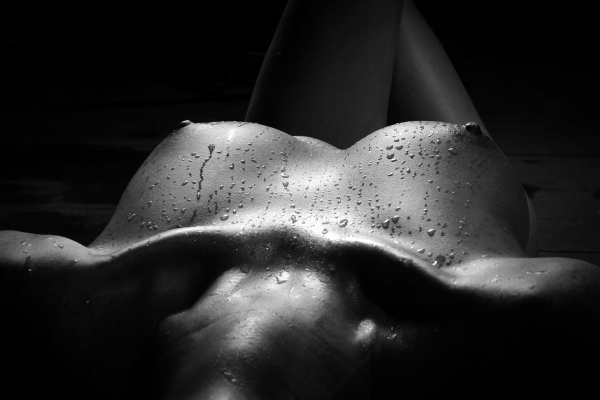



















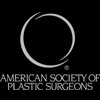
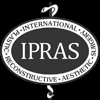
Follow us

